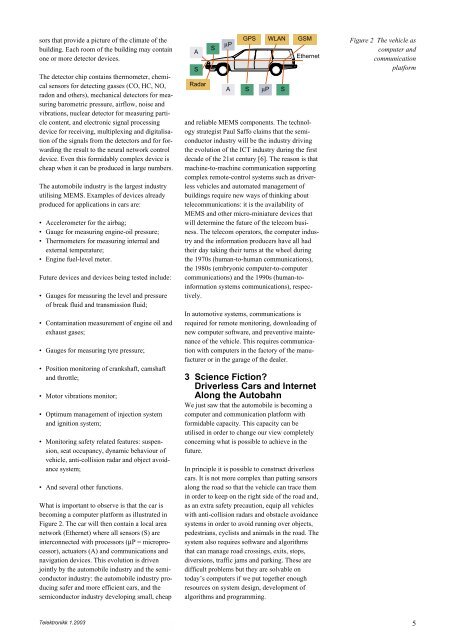Intelligent Transport Systems - Telenor
Intelligent Transport Systems - Telenor
Intelligent Transport Systems - Telenor
You also want an ePaper? Increase the reach of your titles
YUMPU automatically turns print PDFs into web optimized ePapers that Google loves.
sors that provide a picture of the climate of the<br />
building. Each room of the building may contain<br />
one or more detector devices.<br />
The detector chip contains thermometer, chemical<br />
sensors for detecting gasses (CO, HC, NO,<br />
radon and others), mechanical detectors for measuring<br />
barometric pressure, airflow, noise and<br />
vibrations, nuclear detector for measuring particle<br />
content, and electronic signal processing<br />
device for receiving, multiplexing and digitalisation<br />
of the signals from the detectors and for forwarding<br />
the result to the neural network control<br />
device. Even this formidably complex device is<br />
cheap when it can be produced in large numbers.<br />
The automobile industry is the largest industry<br />
utilising MEMS. Examples of devices already<br />
produced for applications in cars are:<br />
• Accelerometer for the airbag;<br />
• Gauge for measuring engine-oil pressure;<br />
• Thermometers for measuring internal and<br />
external temperature;<br />
• Engine fuel-level meter.<br />
Future devices and devices being tested include:<br />
• Gauges for measuring the level and pressure<br />
of break fluid and transmission fluid;<br />
• Contamination measurement of engine oil and<br />
exhaust gases;<br />
• Gauges for measuring tyre pressure;<br />
• Position monitoring of crankshaft, camshaft<br />
and throttle;<br />
• Motor vibrations monitor;<br />
• Optimum management of injection system<br />
and ignition system;<br />
• Monitoring safety related features: suspension,<br />
seat occupancy, dynamic behaviour of<br />
vehicle, anti-collision radar and object avoidance<br />
system;<br />
• And several other functions.<br />
What is important to observe is that the car is<br />
becoming a computer platform as illustrated in<br />
Figure 2. The car will then contain a local area<br />
network (Ethernet) where all sensors (S) are<br />
interconnected with processors (µP = microprocessor),<br />
actuators (A) and communications and<br />
navigation devices. This evolution is driven<br />
jointly by the automobile industry and the semiconductor<br />
industry: the automobile industry producing<br />
safer and more efficient cars, and the<br />
semiconductor industry developing small, cheap<br />
Telektronikk 1.2003<br />
A<br />
S<br />
Radar<br />
S<br />
µP<br />
A<br />
GPS<br />
S<br />
WLAN<br />
µP S<br />
GSM<br />
Ethernet<br />
and reliable MEMS components. The technology<br />
strategist Paul Saffo claims that the semiconductor<br />
industry will be the industry driving<br />
the evolution of the ICT industry during the first<br />
decade of the 21st century [6]. The reason is that<br />
machine-to-machine communication supporting<br />
complex remote-control systems such as driverless<br />
vehicles and automated management of<br />
buildings require new ways of thinking about<br />
telecommunications: it is the availability of<br />
MEMS and other micro-miniature devices that<br />
will determine the future of the telecom business.<br />
The telecom operators, the computer industry<br />
and the information producers have all had<br />
their day taking their turns at the wheel during<br />
the 1970s (human-to-human communications),<br />
the 1980s (embryonic computer-to-computer<br />
communications) and the 1990s (human-toinformation<br />
systems communications), respectively.<br />
In automotive systems, communications is<br />
required for remote monitoring, downloading of<br />
new computer software, and preventive maintenance<br />
of the vehicle. This requires communication<br />
with computers in the factory of the manufacturer<br />
or in the garage of the dealer.<br />
3 Science Fiction?<br />
Driverless Cars and Internet<br />
Along the Autobahn<br />
We just saw that the automobile is becoming a<br />
computer and communication platform with<br />
formidable capacity. This capacity can be<br />
utilised in order to change our view completely<br />
concerning what is possible to achieve in the<br />
future.<br />
In principle it is possible to construct driverless<br />
cars. It is not more complex than putting sensors<br />
along the road so that the vehicle can trace them<br />
in order to keep on the right side of the road and,<br />
as an extra safety precaution, equip all vehicles<br />
with anti-collision radars and obstacle avoidance<br />
systems in order to avoid running over objects,<br />
pedestrians, cyclists and animals in the road. The<br />
system also requires software and algorithms<br />
that can manage road crossings, exits, stops,<br />
diversions, traffic jams and parking. These are<br />
difficult problems but they are solvable on<br />
today’s computers if we put together enough<br />
resources on system design, development of<br />
algorithms and programming.<br />
Figure 2 The vehicle as<br />
computer and<br />
communication<br />
platform<br />
5
















